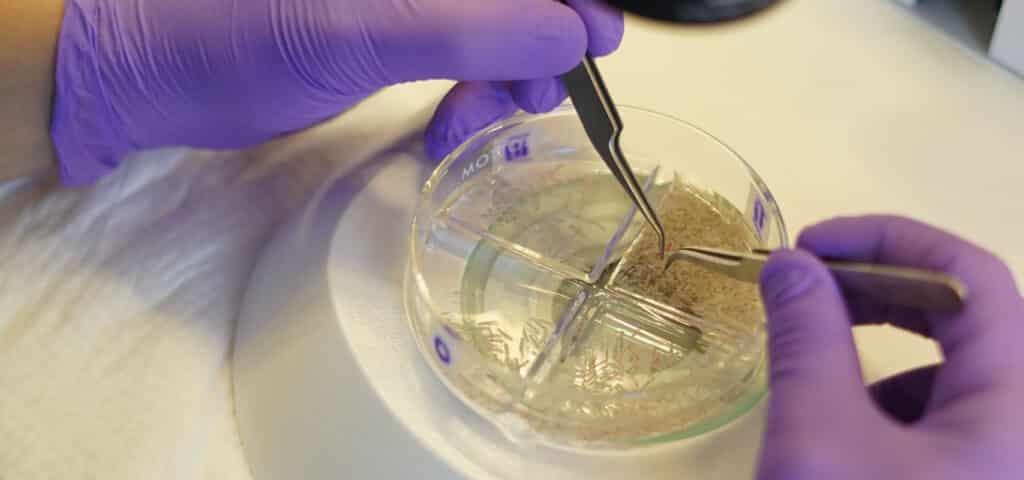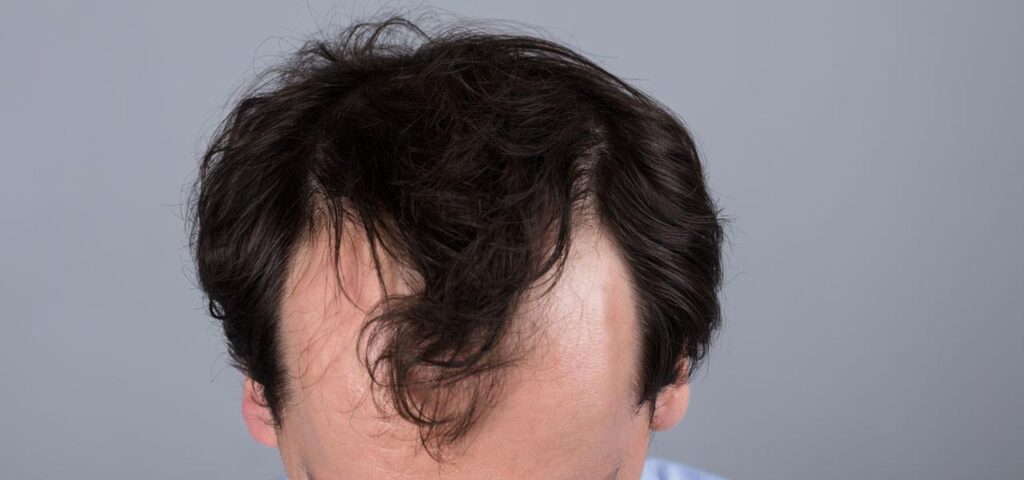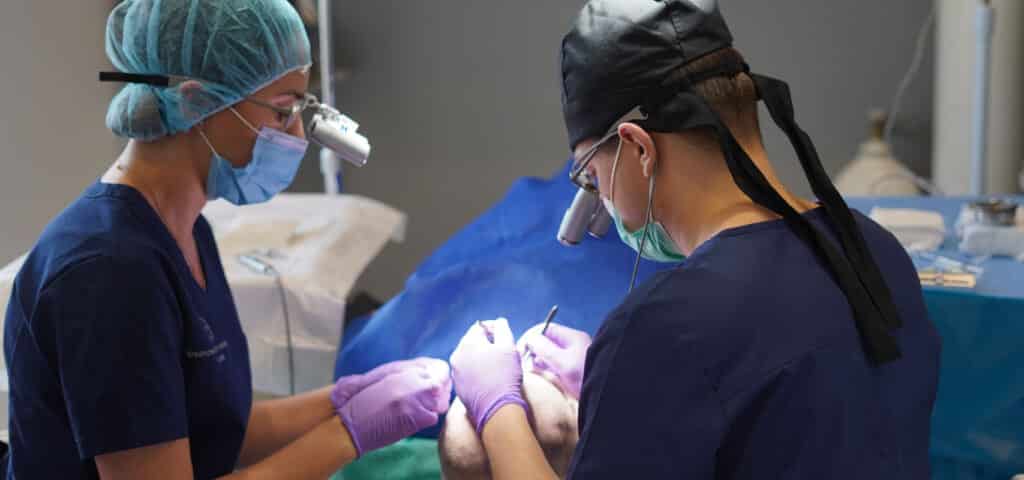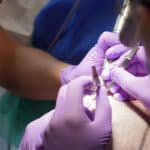One of the most common questions asked by patients planning a hair transplant is: “How many grafts will I need?” The answer is not straightforward, as the number of grafts depends on many individual factors, such as the degree of hair loss, the quality of the donor hair, and the desired density. In this article, we explain how the required number of grafts is determined and the methods used at Piotr Turkowski’s Clinic to create a precise treatment plan.
What are hair grafts?
Grafts (from the English hair grafts) are the basic units used in hair transplantation. Each graft is a small section of scalp containing 1 to 4 hair follicles – the natural “roots” of hair. It is these follicles, not the hairs themselves, that are transplanted during surgery.
A graft is therefore a tiny piece of skin containing follicles – the structures responsible for hair growth. One graft usually contains between 1 and 4 follicles, meaning that a single graft can produce several hairs after transplantation. In modern hair restoration, the follicles are transferred rather than the hair strands, allowing them to grow new, healthy hair in previously bald or thinning areas.

Grafts are most often harvested from the so-called donor area – the back and sides of the scalp, which are genetically resistant to hair loss. They are then precisely implanted into the recipient area, where hair density has diminished. Thanks to modern techniques such as FUE (Follicular Unit Extraction), grafts can be removed individually without leaving visible scars, resulting in a natural-looking outcome.
Thus, grafts are the foundation of the entire transplantation process. Their quality, number, and placement directly determine the final appearance, density, and longevity of the results.
Learn more: What are hair grafts and how are they harvested?
When is a graft transplant recommended?
Hair transplantation is indicated when hair loss is advanced enough that other treatments – such as medication, supplements, or cosmetic concealers – are no longer effective. This most often applies to patients with androgenetic alopecia, a genetic condition that progresses with age. In these cases, a transplant is the only reliable and permanent way to restore coverage in bald or severely thinned areas.

A transplant may also be indicated in patients with scars caused by injury, burns, or surgery. Sometimes it is performed for purely aesthetic reasons – for example, to correct a receding hairline, fill temples, or improve crown density. The key requirement is having a sufficient number of healthy follicles in the donor area. Without this, it is not possible to achieve a natural and lasting effect.
The decision to undergo transplantation is always made individually after a thorough scalp evaluation, assessment of the type of hair loss, and discussion of patient expectations.
How does a hair graft transplant work?
The procedure consists of transferring follicles from one part of the body – usually the back or sides of the scalp – to areas affected by baldness. It is a microsurgical procedure that restores natural hair growth in balding areas.
The process begins with harvesting grafts, each containing 1–4 follicles. With modern methods such as FUE, each graft is extracted individually with specialized micro-tools, minimizing tissue trauma and eliminating the need for large incisions. In the older FUT (Strip) method, a strip of scalp was removed, from which grafts were then separated under a microscope.

Once the recipient area is prepared, the surgeon creates microchannels into which the grafts are implanted. The angle, direction, and density of placement are carefully matched to the patient’s natural hair growth pattern to ensure realistic results.
The procedure is performed under local anesthesia and is generally well tolerated. Small scabs form over the first few days, while visible regrowth begins after several months, when the transplanted follicles resume a normal growth cycle.
How does the surgeon determine the number of grafts?
Determining the number of grafts is one of the most critical planning steps and is always individualized based on the patient’s scalp condition, expectations, and donor capacity. The doctor not only decides how many grafts are needed but also evaluates how many can safely be extracted without over-thinning the donor area.
The process begins with an assessment of hair loss severity, often using the Norwood-Hamilton scale (for men) or Ludwig scale (for women). This helps estimate how much surface area must be covered. The donor hair is then evaluated for density and quality – thick, dark hair produces better visual coverage and may require fewer grafts. Patient expectations also matter – whether they want a dense, full look or a subtler improvement.
Based on these factors, the doctor can calculate the required graft count, usually with the formula: recipient area size (cm²) × target graft density (e.g., 30–50/cm²). Specialized imaging tools and trichoscopy are often used for added precision.
Final decisions combine technical assessment, medical expertise, and aesthetic judgment to deliver a natural and lasting outcome.
What are the methods of graft transplantation?
There are two main techniques that differ in how follicles are harvested from the donor area: FUE and FUT. Both have their advantages and are selected based on patient needs, hair type, scalp condition, and surgeon expertise.
FUE (Follicular Unit Extraction) involves removing individual grafts with a micro-punch tool, without cutting or stitching. This method leaves no visible linear scar, allows faster recovery, and provides highly natural results. It is now the most popular technique worldwide.
See more: Hair transplant methods: FUE, ARTAS, STRIP
FUT (Strip method) involves surgically removing a narrow strip of scalp from the back of the head. Under a microscope, this strip is divided into individual grafts, which are then transplanted into balding areas. While this method is more invasive and leaves a linear scar, it allows harvesting a larger number of grafts quickly, which can be useful in advanced baldness cases.
At Piotr Turkowski’s Clinic, we also use advanced FUE variations such as Sapphire FUE (using sapphire blades) and DHI (Direct Hair Implantation), which allows immediate placement of grafts without prior incisions. These innovations enhance precision and shorten recovery.
Choosing the right method is always preceded by a detailed consultation, during which the doctor evaluates scalp condition, donor quality, and patient goals to recommend the best solution.



